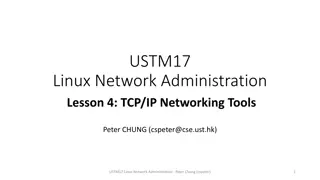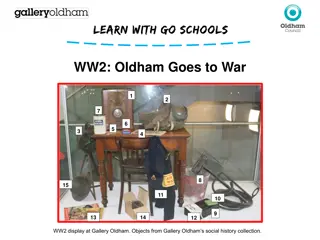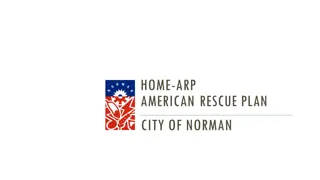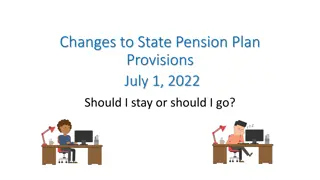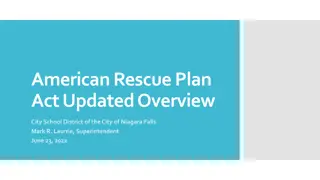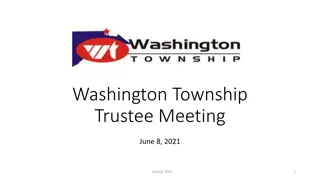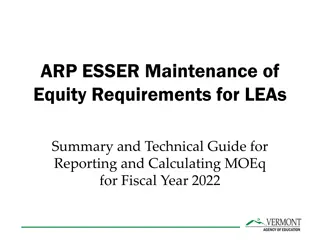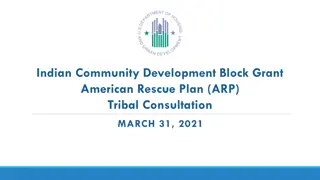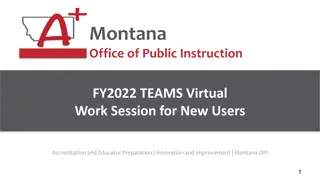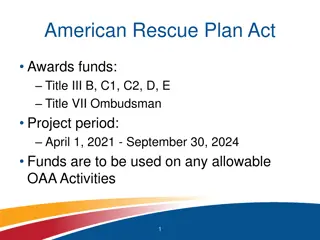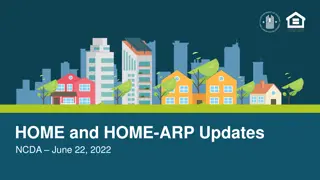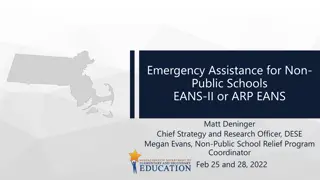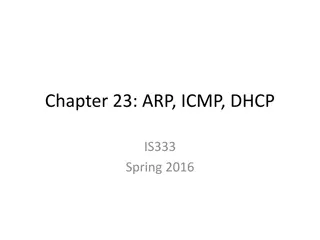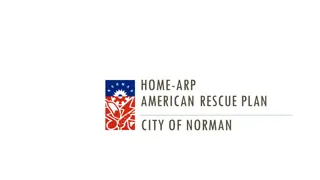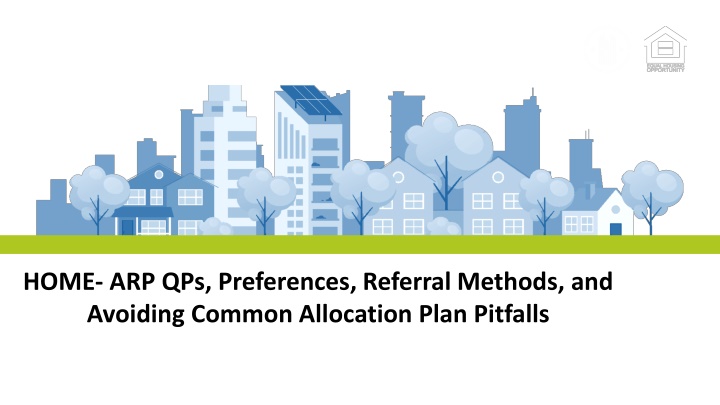
HOME-ARP: Qualifying Populations, Preferences, Referral Methods, and Allocation Plans
Explore the criteria for Qualifying Populations under HOME-ARP, including homelessness, risk of homelessness, domestic violence victims, and more. Learn how to avoid common pitfalls in allocation planning and ensure equitable access for all groups.
Download Presentation

Please find below an Image/Link to download the presentation.
The content on the website is provided AS IS for your information and personal use only. It may not be sold, licensed, or shared on other websites without obtaining consent from the author. If you encounter any issues during the download, it is possible that the publisher has removed the file from their server.
You are allowed to download the files provided on this website for personal or commercial use, subject to the condition that they are used lawfully. All files are the property of their respective owners.
The content on the website is provided AS IS for your information and personal use only. It may not be sold, licensed, or shared on other websites without obtaining consent from the author.
E N D
Presentation Transcript
HOME- ARP QPs, Preferences, Referral Methods, and Avoiding Common Allocation Plan Pitfalls May 15, 2020
Qualifying Populations Homeless as defined at 24 CFR 91.5 (1), (2), and (3) Not paragraph (4) At Risk of Homelessness as defined at 24 CFR 91.5 Fleeing/Attempting to Flee Domestic Violence, Dating Violence, Sexual Assault, Stalking, or Human Trafficking Domestic Violence, Dating Violence, Sexual Assault, and Stalking from VAWA regulation at 24 CFR 5.2003 Human Trafficking from Trafficking Victims Protection Act of 2000 Other Populations: 1) Families Requiring Services or Housing Assistance to Prevent Homelessness OR 2) Those At Greatest Risk of Housing Instability 3
QP Other Populations (1 of 2) Other Families Requiring Services or Housing Assistance to Prevent Homelessness: Households (i.e., individuals and families) who: have previously been qualified as homeless as defined in 24 CFR 91.5 ; are currently housed due to temporary or emergency assistance, including financial assistance, services, temporary rental assistance or some type of other assistance to allow the household to be housed; and need additional housing assistance or supportive services to avoid a return to homelessness. 4
QP Other Populations (2 of 2) At Greatest Risk of Housing Instability means a household that has: Annual income 30% of area median income and is experiencing severe cost burden (paying > 50% of monthly household income toward housing costs); OR Annual income 50% of area median income and meets one of the conditions in paragraph (iii) of At risk of homelessness definition at 91.5 5
Assisting Qualifying Populations Congress intended that all four QPs be served by HOME-ARP PJs must provide all QPs with access to its HOME-ARP program This means that all four QPs must be eligible to apply for/be referred to HOME- ARP projects and activities Implementation of preferences may not exclude or remove eligibility of any QP from its HOME-ARP program PJs must design and administer its HOME-ARP program to ensure that all QPs have access to their programs Allocation plan must address needs & housing/shelter/service gaps of each QP Preferences must be identified in allocation plan 6
Preferences, Methods of Prioritization, and Limitations in HOME-ARP 7
What is a Preference? In HOME-ARP, PJs are permitted to establish reasonable preferences: Among the four QPs (e.g., Homeless QP, Other Populations QP); or For a subpopulation of QP(s) to prioritize applicants within one or more QPs (e.g., elderly who are in the At-Risk of Homelessness QP) Preferences must comply with all applicable fair housing, civil rights, and nondiscrimination requirements, (e.g., Fair Housing Act, Title VI of Civil Rights Act, section 504, HUD s Equal Access Rule, and ADA) If preferences are not adopted, QP applicants are selected from a project- or activity-specific waiting list in chronological order to the extent practicable 8
Implementing Preferences Preferences can be implemented in several ways: Projects or activities that will target assistance to a certain QP (e.g., Homeless QP) or subpopulations (e.g., persons in the Homeless QP who are veterans) Project selection processes (e.g., RFP, NOFA, etc.) that apply a preference in the award of funds (e.g., rank projects higher or award bonus points for serving a certain QP or a subpopulation of a QP) Referral methods that prioritize certain QPs or subpopulations of a QP 9
What is a Method of Prioritization? Method of prioritization (MOP) is process by which PJ, CE, subrecipient, or project owner determines how two or more eligible QP applicants who qualify for the same or different preferences are selected for HOME-ARP assistance A PJ cannot implement a MOP if it does not also establish preference(s) Without a preference, PJ admits applicants to HOME-ARP projects or activities in chronological order) CEs routinely implement MOPs for CoC programs 10
Example: Method of Prioritization PJ adopts a preference for chronically homeless (CH) individuals and families for HOME-ARP rental project. The preference gives CH Homeless QP applicants priority for admission to project. All other QP applicants (including Homeless QP applicants who are not CH) are selected in chronological order for any units not occupied by CH Homeless QP applicants. Chronically homeless QP applicants are prioritized for admission for occupancy based on length of time they have been homeless. Preference is for a subpopulation of a single QP (CH members of HOME-ARP Homeless QP), who will be admitted before all other QP applicants Method of Prioritization applies to CH Homeless QP applicants, who are prioritized for admission based on length of homelessness 11
What are Limitations? Limitations exclude certain QPs or subpopulations of QPs from eligibility for a project or activity (unlike preferences (which provide priority to a QP or a subpopulation Some limitations violate fair housing and civil rights laws (including protections for disabled) Limitations can make it difficult for PJ to meet ARP requirement that all four QPs have access to its HOME-ARP program PJs should not impose a limitation on eligibility unless: It is necessary to address a greater gap in effective housing, aid, benefit, or services in the PJ s geographic area; and Project or activity cannot address the gap through the use of a preference Limitations not permitted for TBRA and supportive services 12
Considerations Related to Limitations/Preferences Before adopting a limitation particularly one that relates directly or indirectly to a protected class HUD strongly recommends conferring with HUD FHEO Same advice holds for certain preferences If PJ implements a limitation on a HOME-ARP project, it must fund at least one other project or activity that provides access to all other QPs of subpopulations of QPs Unlike limitations, preferences do not limit access to all QPs If establishing preferences or limitations, pay close attention to allocation plan requirements related to preferences (e.g., tying preferences to priority needs) 13
Projects and Activities without Preferences If PJ does not establish a preference in its HOME-ARP allocation plan, it cannot implement a preference in any project or activity Limitations/MOP must also be identified in plan If PJ does not adopt preferences, it must admit all QP applicants for HOME-ARP project or activities in chronological order of their application (without any preference or prioritization) This may limit use of CoC CEs as a referral method in HOME-ARP because their primary purpose is to apply preferences and MOP 14
Determining HOME-ARP Referral Methods PJ s decisions re: preferences, MOP, and limitations affect referral methods it uses for projects and activities PJs must also take differences between HOME ARP QP definitions and similar definitions used in other HUD programs into account. CoC CE cannot be used without being expanded/augmented because: CEs don t include all QPs; all QPs must have access to HOME-ARP CEs employ MOP which: 1) implement preferences; and 2) may not be the preferences or MOP the PJ adopted HOME-ARP For additional discussion of referral methods, see Section IV of the HOME-ARP Notice (CPD 21-10) 16
HOME-ARP Referral Methods Expanded Coordinated Entry - PJ can contract with CE or CEs operating within its boundaries to accept applications and refer clients to HOME-ARP projects/activities only if: CE expands to accept all HOME-ARP QPs It applies the preferences and prioritization established in the PJ s HOME-ARP allocation plan Coordinated Entry with Other Referral Methods PJ can use CE for certain QPs and supplement with referrals from other agencies or project-specific waiting lists to ensure access to all QPs 17
HOME-ARP Referral Methods Project/Activity-Specific Waiting Lists established for each HOME-ARP project or activity Can be used with or without preferences Can be used with limitations All qualifying households that apply are placed on the list. Applicants: Selected in accordance with any preference or MOP established for project and adopted in allocation plan: OR Selected in chronological order, to the extent practicable. If a PJ does not have preferences, this is default referral method and applicants are selected in chronological order CE and other agencies can refer clients to the waiting list 18
Tips for Successful HOME-ARP Allocation Plans PJs have everything needed to create compliant HOME-ARP allocation plan HOME-ARP Notice Allocation Plan Template/Tips for Completing the Template Common Issues in HOME-ARP Allocation Plans Allocation Plan FAQs Public Participation Video FAQ Housing Production Goal Calculation Spreadsheet/FAQ Policy Brief: Preferences, Referral Methods, And Allocations Webinar: Preferences, Methods of Prioritization & Allocation Plan Req ts (5/17) HUD Allocation Plan Review Checklist E-Tutorial on Submitting Allocation Plan in eCon Planning Suite HOME Allocation Plan Ask-A-Question Desk Direct Technical Assistance through Community Compass 20
Consultation Requirements Before developing its plan, at minimum a PJ must consult with: CoC(s) serving the jurisdiction s geographic area; Homeless and domestic violence service providers; Veterans groups; Public housing agencies (PHAs); Public agencies that address the needs of the qualifying populations; and, Public/private organizations that address fair housing, civil rights, and needs of persons with disabilities In the plan, a PJ must: Describe the consultation process; List the organizations consulted; and, Summarize the feedback received 21
Consultation: Common Issues/Compliance Tips Inadequate Consultation PJ does not consult with all organizational types or identify organization type PJ does not list all organizations consulted PJ does not consult with organizations on needs of all 4 QPs Compliance Tips Consult every type of organization required; list all organizations consulted by organization type; and make sure to cover all four QPs Best practice Explain how input affected decisions re: preferences and referral methods. 22
Public Participation Before submitting the plan, a PJ must: Provide notice/public comment period of at least 15 calendar days; Follow notice and comment for plan amendments in its current citizen participation plan; Hold at least one public hearing during development of plan; and, Comply with civil rights requirements for participation (reasonable accommodations/access for disabled and limited English proficiency) PJs must make the following available to the public: Amount of HOME-ARP funds the PJ will receive Description of four eligible activities. 23
Public Participation: Common Issues/ Compliance Tips Inadequate Public Participation Not informing public of all possible eligible activities Not making plan available for at least 15 days If combined with other meetings, not identifying as HOME-ARP hearing Notice lacked information on requesting reasonable accommodations for hearing and meaningful access to the plan Compliance Tips: Do all those things. Best practice: Include screenshot of public notice in plan submission to document compliance for HUD 24
Needs Assessment and Gap Analysis Plan must: Quantify each of the QPs, including size and demographic composition; Assess the unmet needs of those populations; Consider current resources available to assist QPs; and, Identify any gaps in the shelter and housing inventory as well as the service delivery system. 25
Needs Assessment and Gap Analysis The plan must include a narrative description that: Identifies characteristics of housing associated with instability and increased risk of homelessness; Identifies gaps within PJ s shelter and housing inventory and service delivery system; Identifies PJ s priority needs for QP; and, Explains how PJ determined level of need and gaps in its shelter and housing inventory and service delivery systems. 26
Needs Assessment Common Issues/Compliance Tips Incomplete Needs Assessments/Gaps Analysis Does not describe size, composition of all four QPs Does not include easily obtainable data Does not assess gaps in housing, shelter, or services for all four QPs Provides data but no narrative Compliance Tips Provide requested data & narrative for all QPs; remember definitional differences If available data is incomplete, acknowledge shortcomings; Estimations OK Best Practices Use CoC consultation to obtain homeless data that reflects PJ s geography. Other Populations data may be obtained through consultation (PHA waitlists, households receiving rapid rehousing assistance, etc.) to estimate QP data. 27
HOME-ARP Activities The plan must: Indicate amount of HOME-ARP funding planned for each eligible activity, including admin and planning; Demonstrate that use of HOME-ARP for nonprofit operating assistance, nonprofit capacity building, and admin costs will be within HOME-ARP limits; Describe how PJ will distribute HOME-ARP funds in accordance with its priority needs; and Describe how the shelter/housing inventory, service delivery system, and the needs identified in the gap analysis provide a rationale for funding planned activities. 28
Planned Activities: Common Issues/Best Practices Problematic Activities: Plan does not identify planned use of funds by eligible activity Plan indicates preferences or limitations in projects or project selection that are not explicitly identified in plan Plan discusses activities that appear to violate fair housing requirements (single sex projects, familial status issues, specific disability) Plan indicates use of impermissible referral processes Compliance Tips Disclose planned preferences in appropriate section Plan with fair housing and civil rights requirements in mind Reread the Referral Method section of the CPD HOME-ARP notice 29
Rental Housing Production Goal Common Issues The plan must: Estimate number of affordable rental housing units for QPs that a PJ will produce or support; Describe the specific affordable rental housing production goal that the PJ hopes to achieve; Narrative discussion is required to describe how the goal will address the PJ s priority needs. Inadequate Rental Housing Goal No narrative discussion included Including NCS units in rental housing goals 30
Production Goals Compliance Tips Compliance Tips Remember the narrative; Use the Rental Housing Production Goal Calculation Spreadsheet and FAQ on the HUD Exchange: https://www.hudexchange.info/resource/6605/homearp-housing-production- goal-calculation-worksheet-and-faq Considerations for estimating a HOME-ARP production goal Amount of HOME-ARP allocated to rental housing activity Availability of other funding sources to finance rental housing projects Housing characteristics required by QP (e.g., size, amenities, etc.) Cost of ongoing HOME-ARP operating assistance, if any 31
Preferences Common Issues If adopting preference(s), plan must Identify preferences to be given to QP(s) or subpopulations of QP(s) Explain how preference will address unmet need or gap in benefits/services Inaccurate Preference Information PJ clearly establishes preferences but states there are none Compliance Tips Recognize preferences to be applied in projects, project selection, or referral methods and disclose in plan Consider whether a preferences would violate any fair housing, civil rights and nondiscrimination requirements 32
Referral Methods PJs are not required to describe referral methods in plan PJ may only use the CoC CE for direct referrals if the CE meets HOME-ARP requirements, including: Expanding to accept all four QP and uses HOME-ARP definitions; and Only using preferences and method(s) of prioritization adopted by the PJ. The plan must specify any MOP to be used for HOME-ARP, including those used by a CE. Identifying CE as referral method without making clear it will be expanded/augmented is a red flag. 33
Limitations in a HOME-ARP Rental or NCS Project The plan must describe whether a PJ will impose any limitations on eligibility for HOME-ARP rental housing or NCS projects. Limitations not permitted for TBRA and Supportive Services The plan must justify the limitation based on the PJ s priority needs in its needs and gaps analysis. If a limitation is identified, the plan must describe how the PJ will address the unmet need of QPs not included in the limitation. 34
Limitations Compliance Tips Impermissible Limitations: Limitations that violate Fair Housing or Civil Rights laws and regulations Limitations that result in any of the four QP being excluded from its overall HOME-ARP program A PJ that imposes a limitation must fund other HOME-ARP activities or projects that provide access to the QPs not included in the limitation. A PJ undertaking only one HOME-ARP project or activity may not impose a limitation because doing so would violate the statute. Best Practices: Do not impose a limitation if a preference would accomplish the PJ s goal. Consult with the local HUD FHEO Division before imposing any preference that might violate fair housing or civil rights laws. 35
Resources HOME-ARP Implementation Notice CPD 21-10 HOME-ARP Implementation Notice Appendix HOME-ARP Policy Brief Preferences, Methods of Prioritization, and Limitations Tips for using the HOME-ARP Allocation Plan Template HOME-ARP Allocation Plan Template HOME-ARP FAQ Training HOME-ARP Notice Review Webinar Series Fall 2021 HOME-ARP Planning Process Webinar November 17, 2021 Field Office CPD Rep. or HOMEARP@hud.gov HOME-ARP Ask A Question portal for allocation plan questions 36
Questions? May 15, 2020


